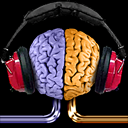Cows produce more milk while listening to music. Who knew?

I did…
A study by British physiologists found that cows increase their milk production by 3-4% while listening to music they like. This varies from classical to Whitney Houston, and there seems to be a need for each farm to optimize music choice for their herd. Overall, milk production improved with slower, mellow music. The idea was taken seriously enough that there was a contest in British Columbia to create the most milk producing melody. The hypothesis behind the increased production is that the music drowns out scary farm noises like tractors, the sound of bad things happening to their friends, or the din from the huge breast pump that milks them.
Music influences your productivity, too!
You may be thinking ‘face – palm’ but stay with me.
Studies spanning 70 decades assimilated by Dr. Adrian North and summarized by Claire Wells, show that lyrics, tempo, and emotions that music elicit could greatly affect responses to your environment, from interactions with coworkers to advertising. Want to increase your confrontational emotions, say to amp you up to ask for a raise? Then you should listen to something hard and fast paced such as Dropkick Murphys. If you need to tolerate doing something repetitive, then electronica or something equally fast paced should help you stay focused. No matter what you like listening to, music at work will improve your attention and attitude. So get your YouTube on and check out bands to prep for their concerts in downtown Urbana Friday night – tell your boss that the ‘distraction’ is a scientifically supported focus!
 You can intentionally change your brain waves and make learning easier by listening to music. According to information published by Chris Boyd Brewer through Johns Hopkins School of Education, integrating music into the classroom can affect all areas of learning by changing brain wave states. During the day your brain passes through many states, often more than one occurs at a given time, but there is always a dominant state. Music can change what the dominant wave is. During school we want to maintain a lot of beta waves, the “focused” ones, with some gamma waves, the “aha” ones, thrown in. Research indicates that music from the Baroque period can help us stay in the learning frame of mind. This process even works in reverse. Your brain waves can make music as well! …and if it ain’t Baroque, why fix it? (Sorry, couldn’t resist.)
You can intentionally change your brain waves and make learning easier by listening to music. According to information published by Chris Boyd Brewer through Johns Hopkins School of Education, integrating music into the classroom can affect all areas of learning by changing brain wave states. During the day your brain passes through many states, often more than one occurs at a given time, but there is always a dominant state. Music can change what the dominant wave is. During school we want to maintain a lot of beta waves, the “focused” ones, with some gamma waves, the “aha” ones, thrown in. Research indicates that music from the Baroque period can help us stay in the learning frame of mind. This process even works in reverse. Your brain waves can make music as well! …and if it ain’t Baroque, why fix it? (Sorry, couldn’t resist.)
What you hear changes what you taste. We all know that presentation is important to how food will taste – it influences our perceptions of “good”. Curiously sounds and music can also change how we taste (North 2012). North had 250 students participate in his study on the perception of the taste of wine based on what music was played during the tasting experience. The types of music ranged from ‘powerful and heavy’ to ‘mellow and soft’ with no music as a control. The type of music directly influenced how the taste of the wine was described. If mellow music was played then the wine was described as mellow. So play ‘yummy’ music during your kid’s least favorite meal and it will taste better!

Tone deafness can reduce the influence of music. Being tone deaf is actually a physiological hearing impairment (although see Monica’s story) that not only effects deficits in ability to hear and play music, but can also create challenges when learning languages. There are several hypotheses of why some people are tone deaf (you can check your aptitude to distinguish tones here). There is evidence of a heritable genetic component, supported by studying linguistics and human populations. There is also a neurological hypothesis that there is a underdeveloped or missing pathway in the brain that does not allow for tone recognition. Both of these hypotheses deal with an innate inability to distinguish tones, however, there are injury related loss of tone differentiation as well. The good news for those that are truly tone deaf, in contrast to being untrained, is that the wavelength in hertz is what actually influences what brain waves are activated.
Wine study reference: North 2012. DOI:10.1111/j.2044-8295.2011.02072.x
Acknowledgements: Jenne Han for reminding me Pygmalion was happening and for thinking my cow factoid was neat.
Images from Wikimedia Commons.








